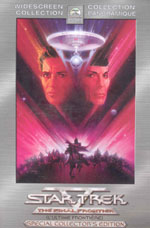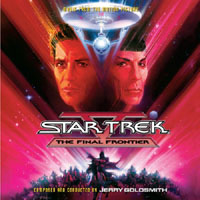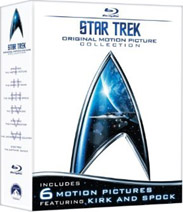
STAR TREK:
Star Trek Movies:
|
Star Trek 5: The Final Frontierstory by William Shatner, Harve Bennett, and David Lougheryscreenplay by David Loughery directed by William Shatner, music by Jerry Goldsmith feature film, 106 minutes
Thankfully, much of the humour works no matter how many times you've seen this. In particular, Shatner, Nimoy, and Kelley prove beyond a doubt why they deserve to be heralded as the great stars of the franchise that they are. Their scenes of banter in this film are some of the best they've EVER done, and these scenes do hold up as classics no matter how many times you've seen them before. James Doohan playing Scotty also does very, very well in this film, and helps keep the bar up really high. Some very good casting happened when Laurence Luckinbill was signed to play the central figure of Sybok, who has to embody a certain ambiguous flirtation with the idea of exactly how dangerous vs. spiritually on-the-money a religious fanatic might be. This is a very difficult and hugely important aspect to get right for this story, and most everyone agrees that Luckinbill did extremely well to bring out everything that was important in this version of the script and make it compelling on screen. David Warner is also advertised as one of the film's big stars, even though his role turns out to be rather less important than the hype would suggest - a role that doesn't really take advantage of his enormous talent. His character really does get upstaged by both Cynthia Gouw playing his Romulan counterpart Caithlin Dar, and Charles Cooper playing his Klingon counterpart General Korrd. Cooper would go on to play a very important recurring figure in Klingon politics in several episodes of The Next Generation TV series shortly after this. The central concept of Nimbus III doesn't quite make sense, if examined too closely. The three major superpowers of this era of Star Trek, who all distrust each other, decide to set-up a kind of perpetual "summit" out in the middle of nowhere, where they are each represented by an individual who has fallen out of favour with the establishment. Exactly what are these three supposed to try to accomplish, all by themselves, with no support staff or security or embassy building? What is the point? How does this rough planet of survival-based thinking get to call itself "The Planet of Galactic Peace?" Perhaps each government gets some bragging rights to say that they are participating here. But this set-up seems to be just begging to be turned into a hostage situation, which is a little too convenient. Add this to the generally seedy, dusty, messy quality of the footage from this planet, whether interiors or exteriors, and I have to admit to having very little desire to watch the Nimbus III sequences. I'm really not sure how the concept of the "laughing Vulcan" was meant to have impact. If you see someone with those ears, and then they laugh, why would you not think that you were looking at a Romulan? Caithlin Dar's long lost love maybe, overjoyed that he's finally made it to the right planet.... So far, we haven't had a Star Trek movie that didn't have some sort of Klingon presence in it somewhere. At this point, the Klingons begin to become terribly overused in the movies, and we get a whole Klingon subplot adding additional action to the movie that somehow doesn't seem to feel all that natural. Captain Klaa and his team seem to be a much less successful repeat of the Klingons we had in Star Trek 3, and seem to be following the same general subplot with a lesser execution. Another repeated subplot is the idea of our favourite crew of regular characters needing to be gathered up and reassembled on the Enterprise in order to begin the adventure, which once more takes up a good chunk of the first half of the film. At least this time around, all these scenes attempt to pluck our funny bones, with varied levels of success. But on that note, it really is only the Kirk-Spock-McCoy scenes that both nail the humour and have truly relevant philosophical territory to cover - and as these prove to be some of the best parts of this film, it does remain worthwhile in the end.
The optical effects for this film unfortunately don't stand up to a great deal of scrutiny.
One will notice that for much of the first sections of the film, if we get an optical at all,
it is often a re-used bit of footage from a previous film. It does indeed seem weird that
reportedly the Enterprise is the only available ship in the area, considering that it is first
revealed as we come up over the Excelsior in a reused shot from the end of Star Trek 4.
I much prefer those moments when new shots have been dropped in. However, it seems a shame
that so many of these shots only feature one object in them - an interactivity problem
that I brought up back in my review of
"Star Trek 1: The Motion Picture". Sure, it doesn't result
in a pacing problem in this film, per se, but it's not doing much to keep the action
sequences interesting and compelling. Rather they turn out to be merely adequate.
Ah well.
Structurally though, the film is doing fairly well. Early on, it promises generous portions
of action, and before long it is delivering. The Enterprise crew all get plenty of chance
to interact with each other all the way through, and they get into the thick of the
action fairly quickly in this one. This film does deliver a good ride, and particularly
on a first run through, one gets the feeling that the adventure backbone of a good Star Trek
story is in place and functioning well.
So just whose viewpoint are we watching here? Captain Kirk's I would think. We the audience
see all the other characters basically in ways in which Kirk might view them, all the way through.
And that's a perfectly fine way to shoot a movie, and can be very artistic. I just have a
feeling that, on this occasion, the filmmakers didn't realize how deep into this territory
they actually were, and didn't see the objective level of reality that was eluding the film.
Thus it didn't quite turn out as well as it might have. A new set of eyes taking an additional
pass over the script probably could have brought this film up another significant notch.
This problem of subjectivity affects many of the elements of the film, but none more so than
how Sybok is perceived, what his powers are, and exactly how Sulu, Uhura, and Chekov respond
to him or Kirk when the question of "freeing their minds" vs. brainwashing comes up, and their
loyalties go off the deep end. To give credit where credit is due, the original plan was
to have Spock and McCoy follow suit as well so that Kirk would wind up as the sole resistor,
but Nimoy and Kelley stepped up to address some of the inconsistencies presented for their characters,
and with a little thought came up with some additions and much more believable positions for
themselves to maintain and/or express.
It is with a bit of a cheesy groan that I received the idea that the God creature had designs
on stealing the Enterprise, because that is such an overused plot device of the Star Trek TV series,
and here it was appearing for the second time in the same movie, delivered in a section of a scene
that wasn't quite working for me. But then again, perhaps it is a GOOD thing that Sybok sees his
false God trying to pull off the same desperate stunt that he himself was forced to do earlier.
It reinforces the unpleasant reflection-of-self re-examination that he is going through.
Perhaps the scene most needs McCoy to notice the repeated plot device and beat the audience
to the groan by making some humorous quip about it.
What we really don't have is the sense that they are truly out of danger - and there are a few
very specific keys for this. One - as the God creature first appears, a great shaft of light
bursts upwards from the planet at his location. It is significant that it goes beyond the height
of the Enterprise and the Klingon ship in orbit, because this signifies that being in orbit
on either of these ships will not put a person out of the range of the God creature's power.
Two - the God creature's dialogue implies that it is the great barrier itself that keeps him
imprisoned here, and that only by crossing back to the other side will a person be out of
range of his power. Three - the Enterprise fires a photon torpedo directly onto the God creature....
after which his voice is heard again and his face is seen to come back and menace Kirk.
This implies that it will take one hell of a great something to actually kill this thing
if killing it is even possible at all... which means that a couple of blasts from the Klingon
ship's laser disruptors won't be doing the trick either. It can at best tick him off,
and buy us a bit of time to beam Kirk up. Once a film pulls one of these "no, the villain
isn't quite dead yet as you thought" stunts, it requires a VERY definitive and spectacular
bit of action to more decisively do the trick later on, and Star Trek Five totally didn't
pull one off.
What we need after Kirk's rescue is a final confrontation over the viewscreen, where perhaps we
can fool the God creature somehow, or outsmart him, or REALLY deliver him a serious blow.
Ideally, it should dove-tail into the central philosophical point being made in the film.
At bare minimum, the Enterprise and Klingon ships need to escape to the other side of the
barrier. We need to get clear of the danger. Then we can carry on and party.
And it is here at the party that we get the real resolution to the film's biggest philosophical
explorations. Is God something outside of ourselves, to be sought? Kirk posits the
philosophy he intends to continue to live by, that God is something internal that we all carry
with us. Perhaps he's right here, in the Human heart. That may seem simple and trite...
but it has more weight to it thanks to us having seen Sybok's journey... all the effort he
went to in recruiting hordes of people, in moving them across the galaxy, just to find
a greedy creature reflecting his own face and his own thieving ways back to him.
I'm less inclined to dismiss these basic spiritual ideas of the film because I have to note
how my own concepts of God and spirituality changed over the years, and more importantly when.
I tended to be a bit more atheist early on, believing our legends of God were more about
misinterpreting an extra-terrestrial presence earlier in our history. Such presences
were "out there" somewhere, technologically advanced but somewhat less than holy.
While I still believe strongly in those possibilities, they have since been dwarfed by
a more universal God presence within all living beings, something that can't be
properly personified as Human religions often try to do. When I look back at WHEN it was
that I was at the right age to form my own opinion, when it was that I became open to
this new point of view, I realize that my first viewing of Star Trek V was right smack
at the beginning of that re-evaluation process. Sybok and the other characters
make the very external journey that I believed Mankind itself should make, and found it
to be severely wanting as I believed it should be, and then Kirk gently suggests something else.
It was just what I needed, and came
along at just the right time for me. I have to think that this film
did have an influence on me then, and I'm forever grateful to it for its contribution
to making a better person out of me, however big or small that contribution was.
No matter how big its other flaws may be, it got something very correct at its core,
and it continues to shine bright because of it.
There are two really stand-out new themes in it. One plays over the second half of the main titles,
during the gorgeous footage of Yosemite National Park, and is often known as "The Mountain".
It's a beautiful piece of slowly ascending glory that comes to represent Kirk's sense of
friendship with his closest shipmates - and it later takes on a sense of gentle intimacy
that most of the other themes don't approach.
Oddly, it's entirely something else from this film's score that has been added to the continuing repertoire that Goldsmith used on the rest of his Star Trek scores after this. It's an oft-repeating simple four-note motif, consisting of a chord's major third, played twice, followed by the base home note, and ending on the major fifth. For example, in the key of C, you'd get E-E-C-G. I grew to think of this motif as representative of Sybok and his questing nature (listen to the scoring on that moment when Spock has him at gunpoint and Sybok marches straight up to point-blank range and dares him to pull the trigger), but I'm not willing to hang on to my original interpretation too closely, since this motif must be finding very different meanings when it comes back in Star Trek's 8, 9, and 10. Whatever it is, it's become a nice, familiar, and very prolific bit of Goldsmith's Trek work. Of course, the Klingon theme is back as well, and gets more widespread use here in this film than in its debut in the first Trek feature of 1979. Here it finally gets a proper workout and many good variations, which we had been awaiting for some time. This excellent theme works very well and is totally welcome, but it gets a bit buggered up by an unnecessary and ugly bird-call that jams itself in. On the film, the bird-call features during the end credits, but the CD thankfully presents end credit music with the bird-call removed. During the film, most cues thankfully give you just pure Klingon music, but when those feature on the CD many of them have the ugly bird-call added in. Don't know what was going on there. Too bad they didn't just leave the bird-call out everywhere - it never sounds good and doesn't work. It's the one true black mark on an otherwise magnificent score.
Read the next Star Trek review: "Star Trek 6: The Undiscovered Country"
Article written by Martin Izsak. Comments on this article are welcome. You may contact the author from this page:
|
|||||||||||||||
|
| ||||||||||||||||

LYRATEK.COM |
|
|||||||||||||||











